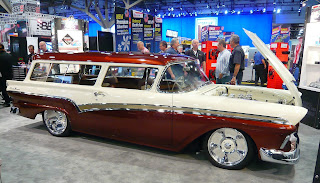Auburn-Cord-Duesenberg
history on display
At the
downsized automobile display at the Blackhawk Museum which now only includes a
single floor of classic automobiles, the author found two artifacts of the
once-mighty Auburn-Cord-Duesenberg triumvirate.
Errett Loban
(EL) Cord took over as the General Manager of the failing Auburn Automobile
Company of Connersville Indiana and worked at no salary with the understanding that
he could acquire controlling interest if he was successful. By lowering prices
and re-painting the cars, Cord quickly turned around the company’s fortunes and
used Auburn as the cornerstone of his Cord Corporation which by 1929 owned 150 companies
that included Lycoming Engines, Checker Cab, Columbia Axle, Stinson aircraft, and
Duesenberg.
The first item of interest on display at
the Blackhawk Museum is this Duesenberg Straight Eight model J engine. This 420-cubic inch engine built by Lycoming in Williamsport Pennsylvania uses dual
overhead camshafts to operate four valves per cylinder which developed a
remarkable for its time 265 horsepower. Transmitting its power through a
three-speed transmission, a Model J Duesenberg could hit 95 miles per hour
(MPH) in second gear with a top speed of nearly 120 MPH.
This engine
built in 1929 was originally fitted to chassis #2175 which has been lost
through the years, although part of that short wheelbase chassis’ original disappearing
top body built by the Walter Murphy Company of Pasadena California was used in
rebuilding Duesenberg #2154.
The other fascinating Auburn-Cord-Duesenberg
artifact at the Blackhawk Museum is this 1935 Auburn 851 supercharged “boat tail”
Speedster. Powered by a 280-cubic inch Lycoming straight eight aluminum head engine
fitted with Bohnalite aluminum pistons and a Schwitzer-Cummins centrifugal
supercharger that turned at six times the crankshaft speed, the engine developed
150 horsepower.
That was enough
power to allow David Abbott “Ab” Jenkins to set 77 worlds records at the Bonneville
Salt Flats over a 24-hour period. The records witnessed by the Contest Board of
the American Automobile Association included a mile at 67.0306 MPH from a
standing start and 100.77 MPH for one mile with a flying start.
The latter run earned the Auburn Speedster the title of “the world’s fastest stock car” and every production 851 Speedster carried a dash plaque (Auburn part number is G5437) signed by Jenkins that certified that the Speedster had been driven over 100 MPH before shipment. It’s doubtful that Jenkins drove each car but there is no question that a supercharged Auburn Speedster could easily attain over 100 MPH.
This particular
Speedster is equipped with a three-speed transmission single-plate clutch and two-speed
Columbia rear end, which allowed the driver to switch between the in-city and
open road axle ratio using a selector on the steering wheel hub.
While this
car designed by Gordon Buehrig was striking and with its “boat tail” design and
chrome exhaust pipes was probably was the dream of many young men in 1935, the
factory had to actually force some Auburn dealers to put a Speedster on display
on their showroom floor. The car had no
virtually no room for luggage and with the top in place, getting in or out of
the Speedster was all but impossible. There were an estimated 500 Speedsters built
in 1935 and 1936, but years later many Speedster replicas of varying build
quality have been built.
Alas, the
Cord Corporation itself collapsed in late 1937 - EL Cord sold out before the
holding company entered bankruptcy and its various assets were sold off by the
bankruptcy court. Auburn renamed American Central fabricated parts
for Jeeps and B-25 bombers during World War II and Lycoming remains in business
today.
After selling
out, EL Cord moved to Beverly Hills where he had previously built Cordhaven, a ten-acre
estate with a $2 million home that enclosed 32,000 square feet, had 62 rooms - 16
bedrooms and 22 bathrooms. EL made several more fortunes in radio, television
and real estate before he died in 1974 but only after Cordhaven was demolished
in 1963 and developed into twelve separate parcels. His grandson Chris Cord was the 1987 IMSA
(International Motor Sports Association) sports car champion.
All color photos by the author












































